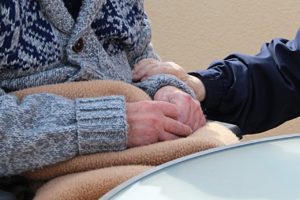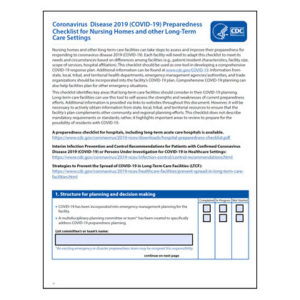Precautions to Take When Admitting Visitors During the COVID-19 Pandemic
 The COVID-19 pandemic has required that senior living facilities implement social distancing to protect their residents and staff. This social distancing has, at least for the time being, largely put an end to family visits, with families and residents keeping in touch by phone or video conference.
The COVID-19 pandemic has required that senior living facilities implement social distancing to protect their residents and staff. This social distancing has, at least for the time being, largely put an end to family visits, with families and residents keeping in touch by phone or video conference.
But in compassionate care situations, facilities may want to allow families to visit with their loved ones. With proper precautions, facilities can achieve these visits while still keeping staff, residents, and families safe.
Establish a Policy to Admit Families
Facilities should develop a policy regarding when families will be admitted, and they should ideally do this before compassionate care situations arise. Nikita B. Williams, BSN-RN, a registered nurse, long-term care specialist, and clinical healthcare consultant, notes that there’s no one-size-fits all policy solution for facilities, and that each facility will need to develop a policy that reflects its dynamics, culture, and the individual situation.
“It is my recommendation that visitations are allowed for immediate family members only,” explains Williams. “Visitations should be limited to no more than one hour, and the number of visitors should be no greater than two at a time.”
It’s advisable to develop a policy that outlines factors like:
- Which situations warrant visitation rights
- Which individuals will be allowed to visit
- The permitted frequency of visits
- The process of granting visitation rights
When these details are outlined in writing, a facility can both grant visitation faster and ensure appropriate decision-making as compassionate care situations arise.
Educate Families Before the Visit
Education and preparation play an important part in keeping everyone safe and ensuring that visits go smoothly. According to the Centers for Disease Control and Prevention’s recommendations for long-term care facilities and nursing homes, facilities should educate families about COVID-19 prevention, outlining the measures the facility is taking to protect residents and how families will need to follow those same preventative measures during visits.
Williams suggests that, when preparing families for visits, the efforts should be spearheaded by an executive director, a director of nursing, or a designee. She states that families should be provided with written communications that outline clear expectations and guidelines for visitation.
“In this communication, it should be required that an appointment for visitation should be made prior to the actual visit, so that the visitations can be monitored upon point of entry and exit. No visitor with a temperature of over 99.0 should be allowed to enter the facility. Families should be made aware that wearing a mask is a non-negotiable. Visitation hours and days should be clearly written and also limited until the restrictions of visitations are lifted and deemed safe for all visitors without compromise.”
Implement Precautions During and After the Visit
Carefully structuring the visits can also help to prevent the spread of COVID-19. The CDC recommends that visitors wear cloth face masks while inside the building. Facilities should restrict visitors’ access to the resident’s room or another designated visit location. During the visit, staff should remind visitors to frequently practice good hand hygiene.
Williams recommends that during the visit, visitors should be prepared to stay in the room without leaving and re-entering. “The family must remember that their loved one is at a higher risk of becoming ill through their visit due to their exposure to the community, as well as the outside elements,” notes Williams.
“Families should focus on sharing memorable moments as well as making new memories during their time with their loved ones to make the best use of their time and experience. When leaving the visit, if shoe covers weren’t worn, families should place their shoes into a bag and launder them prior to wearing them again.”
According to the CDC, a facility should ask visitors to reach out if they develop a fever or COVID-19 symptoms within 14 days of their visit.
While alternative visit methods, like video calls, should continue for most residents and families, being able to provide in-person visits in compassionate care situations can make these difficult times easier for families and residents. With proper precautions, facilities can minimize the risk of COVID-19 transmission when these visits do need to occur.

Paige Cerulli is a contributing writer to i Advance Senior Care.
Related Articles
Topics: Activities , Administration , Departments , Featured Articles , Infection control , Leadership , Policy , Resident Care , Staffing









